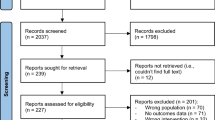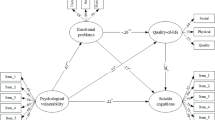Abstract
The Snaith-Hamilton Pleasure Scale (SHAPS) is a rapid screening battery created for assessing the presence of anhedonia, namely the inability to experience pleasure. Although, this symptom has widely been investigated in clinical settings, individual differences in anhedonia are also present in healthy population. The aim of present study was to validate the translated Italian version of this test. One thousand six hundred ninety-seven consecutive healthy subjects (55% female) of different ages (age 18–82 years) underwent SHAPS. Participants who showed mild level of anhedonia also completed the Apathy Evaluation Scale (AES), Beck Depression Inventory (BDI), Toronto Alexithymia Scale-20 (TAS), Mood Disorders Insight Scale (MDIS), and Beck Hopelessness Scale (BHS). The SHAPS showed good internal consistency and discriminant validity; moreover, the factorial analysis highlighted that SHAPS had a three-factor structure for explaining the anhedonic construct. 14.9% showed a significant reduction of hedonic tone (SHAPS ≥ 3). Finally, the degree of anhedonia was significantly correlated with BDI and BHS scores, but not with age or gender. Although anhedonia is a prominent feature of many psychiatric and neurological disorders, the presence of this symptom in the healthy population highlighted the importance to develop reliable tool. SHAPS shows good psychometric properties to assess multidimensional anhedonia symptoms also in Italian healthy population.
Similar content being viewed by others
References
Ribot T (1986) La psychologie des sentiment. Felix Alcan, Paris
Ho N, Sommers M (2013) Anhedonia: a concept analysis. Arch Psychiatr Nurs 27(3):121–129. https://doi.org/10.1016/j.apnu.2013.02.001
Strauss GP, Gold JM (2012) A new perspective on anhedonia in schizophrenia. Am J Psychiatry 169(4):364–373. https://doi.org/10.1176/appi.ajp.2011.11030447
Ritsner MS, Arbitman M, Lisker A (2011) Anhedonia is an important factor of health- related quality-of-life deficit in schizophrenia and schizoaffective disorder. J Nerv Ment Dis 199(11):845–853
Fletcher K, Parker G, Paterson A et al (2015) Anhedonia in melancholic and non-melancholic depressive disorders. J Affect Disord 184:81–88
Wang J, Huang J, Yang XH et al (2015) Anhedonia in schizophrenia: deficits in both motivation and hedonic capacity. Schizophr Res 168(1–2):465–474
Natta L, Melrose R, Harwood D, Sultzer D (2013) An examination of anhedonia separate from depression in Alzheimer’s disease: a preliminary study. Am J Geriatr Psychiatry 21(3):S78–S79. https://doi.org/10.1016/j.jagp.2012.12.102
Santangelo G, Morgante L, Savica R et al (2009) Anhedonia and cognitive impairment in Parkinson's disease: Italian validation of the Snaith-Hamilton Pleasure Scale and its application in the clinical routine practice during the PRIAMO study. Parkinsonism Relat Disord 15(8):576–581
Loas G, Krystkowiak P, Godefroy O (2012) Anhedonia in Parkinson’s disease: an overview. J Neuropsychiatry Clin Neurosci 24(4):444–451
Keller J, Young CB, Kelley E et al (2013) Trait anhedonia is associated with reduced reactivity and connectivity of mesolimbic and paralimbic reward pathways. J Psychiatr Res 47(10):1319–1328. https://doi.org/10.1016/j.jpsychires.2013.05.015
Rizvi SJ, Pizzagalli DA, Sproule BA, Kennedy SH (2016) Assessing anhedonia in depression: potentials and pitfalls. Neurosci Biobehav Rev 65:21–35. https://doi.org/10.1016/j.neubiorev.2016.03.004
Zhang H, Harris L, Split M et al (2016) Anhedonia and individual differences in orbitofrontal cortex sulcogyral morphology. Hum Brain Mapp 37(11):3873–3881
Opel N, Zwanzger P, Redlich R et al (2016) Differing brain structural correlates of familial and environmental risk for major depressive disorder revealed by a combined VBM/pattern recognition approach. Psychol Med 46(2):277–290
Chapman L, Chapman J, Raulin M (1976) Scales for physical and social anhedonia. J Abnorm Psychol 85:374–382
Snaith RP (1993) Anhedonia: a neglected symptom of psychopathology. Psychol Med 23(04):957–966. https://doi.org/10.1017/S0033291700026428
Snaith RP, Hamilton M, Morley S et al (1995) A scale for the assessment of hedonic tone the SnaitheHamilton Pleasure Scale. Br J Psychiatry 167:99–103
Liu WH, Wang LZ, Zhu YH et al (2012) Clinical utility of the Snaith-Hamilton-Pleasure scale in the Chinese settings. BMC Psychiatry 12:184
Franken IH, Rassin E, Muris P (2007) The assessment of anhedonia in clinical and non-clinical populations: further validation of the Snaith-Hamilton Pleasure Scale (SHAPS). J Affect Disord 99:83–89
Franz M, Lemke MR, Meyer T et al (1998) German version of the Snaith-Hamilton-Pleasure Scale (SHAPS-D). Anhedonia in schizophrenic and depressive patients. Fortschr Neurol Psychiatr 66(09):407–413. https://doi.org/10.1055/s-2007-995279
Loas G, Dubal S, Perot P et al (1997) Validation of the French version of the Snaith-Hamilton Pleasure Scale (SHAPS, Snaith et al. 1995). Determination of the statistical parameters in 208 normal subjects and 103 hospitalized patients presenting with depression or schizophrenia. Encéphale 23:454–458
Göritz AS, Reinhold N, Batinic B (2002) Online panels. In: Batinic B, Reips U, Bosnjak M (eds) Online social sciences. Hogrefe & Huber Publishers, Seattle, pp 27–47
Assogna F, Cravello L, Caltagirone C, Spalletta G (2011) Anhedonia in Parkinson’s disease: a systematic review of the literature. Mov Disord 26(10):1825–1834. https://doi.org/10.1002/mds.23815
Marin RS, Biedrzycki RC, Firinciogullari S (1991) Reliability and validity of the Apathy evaluation Scale. Psychiatry Res 38(2):143–162. https://doi.org/10.1016/0165-1781(91)90040-V
Beck AT, Steer RA, Brown GK (1996) Manual for the Beck Depression Inventory-II. Psychological Corporation, San Antonio
Bagby RM, Taylor GJ, Parker JD (1994) The twenty-item Toronto Alexithymia Scale-II: convergent, discriminant, and concurrent validity. J Psychosom Res 38(1):33–40. https://doi.org/10.1016/0022-3999(94)90006-X
Sturman ED, Sproule BA (2002) Toward the development of a mood disorders insight scale: modification of Birchwood’s Psychosis Insight Scale. J Affect Disord 77:21–30
Beck AT, Weissman A, Lester D, Trexler L (1974) The measurement of pessimism: the hopelessness scale. J Consult Clin Psychol 42(6):861–865. https://doi.org/10.1037/h0037562
Hays RD, Anderson R, Revicki D (1993) Psychometric considerations in evaluating health-related quality of life measures. Qual Life Res 2(6):441–449
Cronbach LJ (1951) Coefficient alpha and the internal structure of tests. Psychometrika 16(3):297–334. https://doi.org/10.1007/BF02310555
Aaronson N, Alonso J, Burnam A, Lohr KN, Patrick DL, Perrin E, Stein RE (2002) Assessing health status and quality-of-life instruments: attributes and review criteria. Qual Life Res 11(3):193–205
Nunnally JC, Bernstein IH (1994) Psychometric theory. McGraw-Hill, New York
Matsui K, Tachibana H, Yamanishi T et al (2013) Clinical correlates of anhedonia in patients with Parkinson’s disease. Clin Neurol Neurosurg 115(12):2524–2527
Aguera-Ortiz L, Failde I, Mico JA et al (2011) Pain as a symptom of depression: prevalence and clinical correlates in patients attending psychiatric clinics. J Affect Disord 130(1–2):106–112
Author information
Authors and Affiliations
Corresponding author
Ethics declarations
All participants gave their written informed consent and the local ethics committee approved the study.
Rights and permissions
About this article
Cite this article
Martino, I., Santangelo, G., Moschella, D. et al. Assessment of Snaith-Hamilton Pleasure Scale (SHAPS): the dimension of anhedonia in Italian healthy sample. Neurol Sci 39, 657–661 (2018). https://doi.org/10.1007/s10072-018-3260-2
Received:
Accepted:
Published:
Issue Date:
DOI: https://doi.org/10.1007/s10072-018-3260-2




